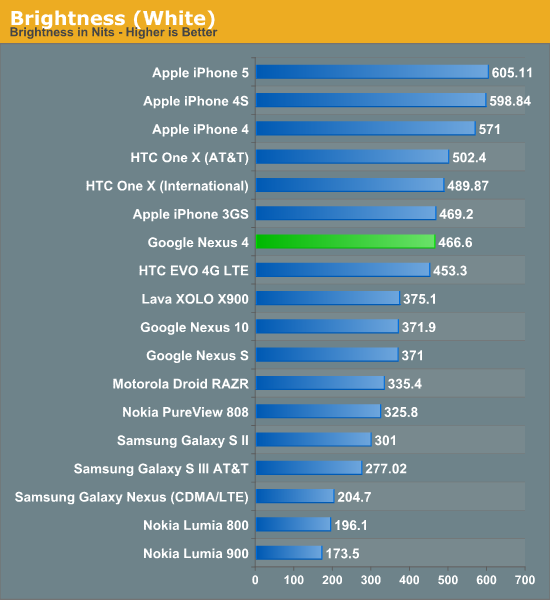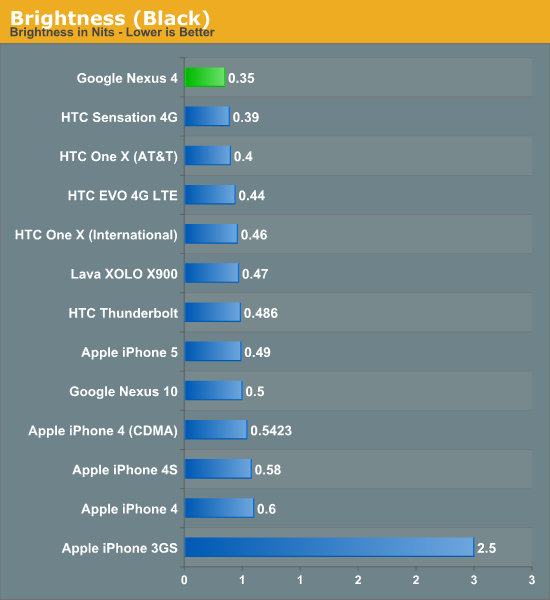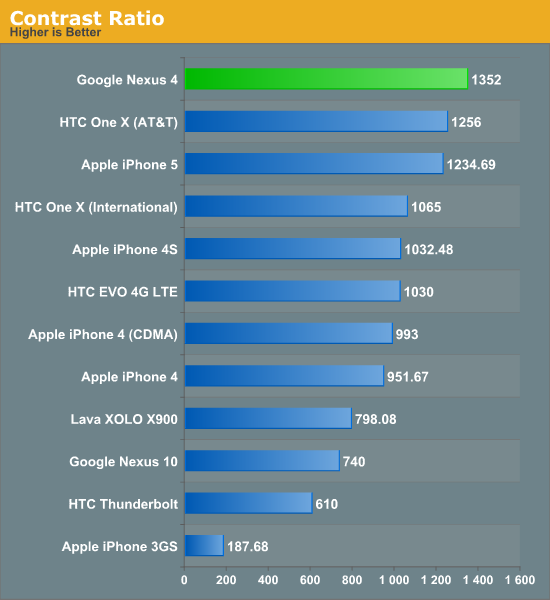Google Nexus 4 Review - Google's new Flagship
by Brian Klug on November 13, 2012 8:45 AM EST- Posted in
- Smartphones
- LG
- Android
- Mobile
- APQ8064
- Nexus 4
- Android 4.2
- MDM9215
The display on the Nexus 4 is another shared component between the Optimus G, and is a 4.7-inch IPS WXGA (1280x768) LCD, which is of course home to an RGB stripe and in-cell touch, or as LG calls it, "zerogap" touch. LG Display unsurprisingly knows how to make LCD displays, and the Nexus 4 display looks subjectively very good. At 320 PPI I can’t see any pixels, and don’t think we need to get into the whole visual acuity discussion again, it’s very good on the Nexus 4. The added width over straight 720p is something I noted was actually very refreshing on the Optimus G when playing with that device in Korea. Most apps scale appropriately and take advantage of it without any issue, and the extra width definitely is noticeable in Chrome, Plume, and all my daily drivers.



The Nexus 4 display goes very bright, at 466 nits, and achieves a contrast ratio of 1352:1 at that maximum brightness setting. This is a huge step over the barely 200 nits that the Galaxy Nexus could eek out.
| CalMAN Display Comparison | |||||||||
| Metric | iPhone 5 | iPhone 4S | HTC One X | Samsung Galaxy S 3 | Samsung Galaxy Note 2 | Google Nexus 4 | |||
| Grayscale 200nits Avg dE2000 | 3.564 | 6.162 | 6.609 | 4.578 | 5.867 | 7.686 | |||
| CCT Avg (K) | 6925 | 7171 | 5944 | 6809 | 7109 | 8506 | |||
| Saturation Sweep Avg dE2000 | 3.591 | 8.787 | 5.066 | 5.460 | 7.986 | 8.517 | |||
| GMB ColorChecker Avg dE2000 | 4.747 | 6.328 | 6.963 | 7.322 | 8.185 | 7.531 | |||
I’ve mentioned that Google continues to struggle at calibrating their displays. The truth is that everyone except for Apple, HTC, and occasionally Samsung, struggle at calibrating mobile displays. This continues to be the case with the Nexus 4, and the result is that accuracy could be better. I’m convinced the results that we’re getting out of the Nexus 4 basically represent no attempt at calibrating the display, and as a result the numbers suffer.
















188 Comments
View All Comments
numberoneoppa - Tuesday, November 13, 2012 - link
Lovely review, Brian, as usual, but I have a question. Forgive me if I just glanced over this, but have you run your benchmarks using the newest OTA which rolled out over the last day or are these running the same software as those posted earlier in the month? In any case, it would be interesting to see if there are any changes in the XML file which seems to specify temperature shelves.Jorange - Tuesday, November 13, 2012 - link
Hi Brian,Can you please confirm that all GL Benchmark tests are run serially for all devices?, as this places them under a greater thermal load, then running the benches individually.
Brian Klug - Tuesday, November 13, 2012 - link
I do whenever possible, always. The issue is what happens when devices crash out before a full run (Optimus G) which then forces my hand to do this piece-by-piece kind of testing and reassemble a whole run.-Brian
MadMan007 - Tuesday, November 13, 2012 - link
You should note which devices have 'assembled scores' versus straight runs in your charts then. An asterik would do.xTRICKYxx - Tuesday, November 13, 2012 - link
By far the best Nexus 4 review; bar none.Kernel developers will easily raise the thermal throttling limit to a much higher temperature, but it is obvious there is a temperature issue.
suhan - Tuesday, November 13, 2012 - link
why is it that you don't use geekbench to measure the actual performance of the device?tuxRoller - Tuesday, November 13, 2012 - link
Because it is closed source thus we dont know exactly what paths it takes (meaning it could disproportionately harm one particular device over another)?Hell, do we need even know what compiler they use? Knowing that and the flags used would certainly be very useful.
HisDivineOrder - Tuesday, November 13, 2012 - link
...this site used to be about custom-built computers?We'd get driver reviews, we'd get hardware other than video cards, motherboards, and CPU's reviewed, we'd get the skinny on new custom PC hardware that was coming...
I'm waxing nostalgic here. I miss those days, I think. These smartphone reviews are just beginning to bore me to tears. Maybe I'm just old, but I miss the good ol' days. Back when phones were something we just lived with rather than something people seem to obsess over now.
Back when having the latest and greatest in computing was more about smart hardware selection and less about going to the store, slapping down your cc, and saying, "Gimme your best, barkeep!"
Medikit - Tuesday, November 13, 2012 - link
I remember those days really well. Mobile computing is the future of the industry. Furthermore Anandtech still reviews computer cases, HTPCs, and the latest, greatest hardware. I like to think of it as the best of both worlds.Alexo - Thursday, November 15, 2012 - link
> Mobile computing is the future of the industry."Mobile computing" will not get truly mobile until we get decent battery life.
Meanwhile, AnandTech keeps lauding devices that have more computing power than most of us ever utilize at the expense of battery life (not to mention non-user-changeable batteries, throttling, etc.)